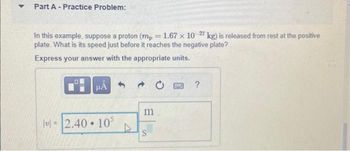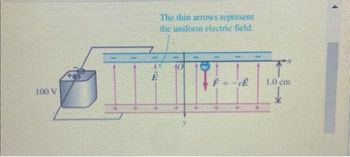
College Physics
11th Edition
ISBN: 9781305952300
Author: Raymond A. Serway, Chris Vuille
Publisher: Cengage Learning
expand_more
expand_more
format_list_bulleted
Concept explainers
Question

Transcribed Image Text:Part A - Practice Problem:
In this example, suppose a proton (mp = 1.67 × 10-27 kg) is released from rest at the positive
plate. What is its speed just before it reaches the negative plate?
Express your answer with the appropriate units.
HÅ
v=2.40 10³
●
m
S
?

Transcribed Image Text:100 V
The thin arrows represent
the uniform electric field.
dio
E
F=-E
1.0 cm
Expert Solution
This question has been solved!
Explore an expertly crafted, step-by-step solution for a thorough understanding of key concepts.
This is a popular solution
Trending nowThis is a popular solution!
Step by stepSolved in 3 steps with 3 images

Knowledge Booster
Learn more about
Need a deep-dive on the concept behind this application? Look no further. Learn more about this topic, physics and related others by exploring similar questions and additional content below.Similar questions
- At locations A and B, the electric potential has the values VA = 1.59 V and VB = 5.87 V, respectively. A proton released from rest at one of these locations passes through the other location. From which location was the proton released? A В What is its speed when it passes through the other location? 2.93 x104 speed: m/s Incorrectarrow_forwardItem 14 Rutherford's Planetary Model of the Atom In 1911, Ernest Rutherford developed a planetary model of the atom, in which a small positively charged nucleus is orbited by electrons. The model was motivated by an experiment carried out by Rutherford and his graduate students, Geiger and Marsden. In this experiment, they fired alpha particles with an initial speed of 1.30 x 107m/s at a thin sheet of gold. (Alpha particles are obtained from certain radioactive decays. They have a charge of +2e and a mass of 6.64 × 10-27 kg.) Part A r = How close can the alpha particles get to a gold nucleus (charge = +79e), assuming the nucleus remains stationary? (This calculation sets an upper limit on the size of the gold nucleus. See Chapter 31 of the textbook for further details.) —| ΑΣΦ Submit Request Answer ? 14 of 15 m Reviewarrow_forwardSuppose that the electric potential outside a living cell is higher than that inside the cell by 0.077 V. How much work is done by the electric force when a sodium ion (charge = +e) moves from the outside to the inside? Number i Units tarrow_forward
- 2 A train of mass 20,000 kg is travelling along a horizontal surface at 35 ms-1 when the driver sees a man tied to the tracks ahead, disengages the engine and applies the brakes. When braking the total resistive force on the train is (4000 + 500v) N, where v is the speed of the train. How far does the train travel before coming to rest?arrow_forward= Two point particles have equal charge q 1100 esu and different masses, m₁ = 25 gr and m₂ = 65 gr, are confined to move freely along the x axis. Note that esu is the unit of electric charge when working with units of mass in grams and distance in centimeters. = The electrical force between the particles is a repelling force which is derived from the potential energy function U(x1, x2) of the two-particles system. U(x1, x2) depends only on the distance of the particles and is given by U(x1, x2) - q2 | x2 − x1| At t = 0) the particle of mass m2 is at rest at the origin (x2 = 0), and the particle of mass m₁ begins to move from point x1 = 76 cm with velocity vo 134 cm/s towards particle m2. = a. What is the location of the center of mass (in cm) at t - 0? -21. b. What is the location of the center of mass (in cm) at t = 0.4 sec? -6.2 c. What will be the minimum distance (in cm) between the two particles? 6.46 X d. Once the distance between the particles is minimal, what will be the speed…arrow_forwardWhat is the electric potential 4.6×10−11 m from a proton (charge +e)? Let V=0 at r=∞.Express your answer using two significant figures. What is the potential energy of an electron at this point?arrow_forward
- so the distance is from -3 to 5 cm which is 8cm or .08m. I did parts a-e and need help for parts f-h. This is what I have so far: a: V1=1000V b: 3.2e^-16 J c. potential energy; no work needed to move particle as it leaves electric field d. 3.2e^-16 J e. m1<m2<m3<m4, v1>v2>v3>v4 f. distance =.08m -time takes particle 1 hit detector: .98e^-6 sec ---> .08m/.98e^-6 s= 8.16e^4 m/s -time takes particle 2 hit detector: 1.4e^-6 s --> .08m/1.4e^-6 s= 5.71e^4 m/s -time takes particle 3 hit detector: 1.7e^-6 s --> .08m/1.7^-6 s= 4.7053^4 m/s -time takes particle 4 hit detector: 1.96^-6 s --> .08m/1.96^-6 s= 4.082e^4 m/s I am not sure if i Made any mistakes so please let me know if i DO!arrow_forward11. An electron in the picture tube of an old television set is accelerated from rest through a potential difference Vba = +5000V. a. What is the change in potential energy of the electron? (ans: -8.0 x 1010 J) b. What is the speed of the electron as a result of this acceleration? (ans: 4.2 x 10' m/s) c. What is the speed of a proton that is accelerated through a potential difference Vba = - 5000 V? (ans: 9.8 x 10° m/s) 020-12-11 Page 4 of 17arrow_forwardSuppose an electron (q = -e = -1.6 x 10¬9 C,m=9.1 x 10¬3' kg) is accelerated from rest through a potential difference of Vab = +5000 V. Solve for %3D the final speed of the electron. Express numerical answer in two significant figures. The potential energy U is related to the electron charge (-e) and potential Vab is related by the equation: U = Assuming all potential energy U is converted to kinetic energy K, K+U = 0 K = -U 1 Since K mv and using the formula for potential energy above, we arrive at an equation for speed: 2 v = ( 1/2 Plugging in values, the value of the electron's speed is: x 107 m/s V=arrow_forward
- Help with the following question, please write the answers on a piece of paperarrow_forward3. Calculate the gravitational field due to a homogeneous cylinder at exterior points on the axis of the cylinder. Perform the calculation by a) computing the force directly and b) computing the potential first.arrow_forwardAn electron moving parallel to the x axis has an initial speed of 3.40 x 106 m/s at the origin. Its speed is reduced to 1.98 x 105 m/s at the point x = 2.00 cm. (a) Calculate the electric potential difference between the origin and that point. Volts (b) which point is at the higher potential? O the point x = 2.00 cm ● the origin O both have the same potentialarrow_forward
arrow_back_ios
SEE MORE QUESTIONS
arrow_forward_ios
Recommended textbooks for you
 College PhysicsPhysicsISBN:9781305952300Author:Raymond A. Serway, Chris VuillePublisher:Cengage Learning
College PhysicsPhysicsISBN:9781305952300Author:Raymond A. Serway, Chris VuillePublisher:Cengage Learning University Physics (14th Edition)PhysicsISBN:9780133969290Author:Hugh D. Young, Roger A. FreedmanPublisher:PEARSON
University Physics (14th Edition)PhysicsISBN:9780133969290Author:Hugh D. Young, Roger A. FreedmanPublisher:PEARSON Introduction To Quantum MechanicsPhysicsISBN:9781107189638Author:Griffiths, David J., Schroeter, Darrell F.Publisher:Cambridge University Press
Introduction To Quantum MechanicsPhysicsISBN:9781107189638Author:Griffiths, David J., Schroeter, Darrell F.Publisher:Cambridge University Press Physics for Scientists and EngineersPhysicsISBN:9781337553278Author:Raymond A. Serway, John W. JewettPublisher:Cengage Learning
Physics for Scientists and EngineersPhysicsISBN:9781337553278Author:Raymond A. Serway, John W. JewettPublisher:Cengage Learning Lecture- Tutorials for Introductory AstronomyPhysicsISBN:9780321820464Author:Edward E. Prather, Tim P. Slater, Jeff P. Adams, Gina BrissendenPublisher:Addison-Wesley
Lecture- Tutorials for Introductory AstronomyPhysicsISBN:9780321820464Author:Edward E. Prather, Tim P. Slater, Jeff P. Adams, Gina BrissendenPublisher:Addison-Wesley College Physics: A Strategic Approach (4th Editio...PhysicsISBN:9780134609034Author:Randall D. Knight (Professor Emeritus), Brian Jones, Stuart FieldPublisher:PEARSON
College Physics: A Strategic Approach (4th Editio...PhysicsISBN:9780134609034Author:Randall D. Knight (Professor Emeritus), Brian Jones, Stuart FieldPublisher:PEARSON

College Physics
Physics
ISBN:9781305952300
Author:Raymond A. Serway, Chris Vuille
Publisher:Cengage Learning

University Physics (14th Edition)
Physics
ISBN:9780133969290
Author:Hugh D. Young, Roger A. Freedman
Publisher:PEARSON

Introduction To Quantum Mechanics
Physics
ISBN:9781107189638
Author:Griffiths, David J., Schroeter, Darrell F.
Publisher:Cambridge University Press

Physics for Scientists and Engineers
Physics
ISBN:9781337553278
Author:Raymond A. Serway, John W. Jewett
Publisher:Cengage Learning

Lecture- Tutorials for Introductory Astronomy
Physics
ISBN:9780321820464
Author:Edward E. Prather, Tim P. Slater, Jeff P. Adams, Gina Brissenden
Publisher:Addison-Wesley

College Physics: A Strategic Approach (4th Editio...
Physics
ISBN:9780134609034
Author:Randall D. Knight (Professor Emeritus), Brian Jones, Stuart Field
Publisher:PEARSON